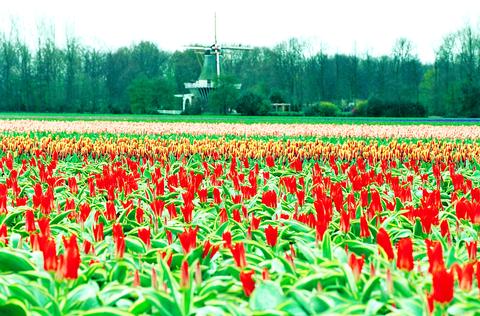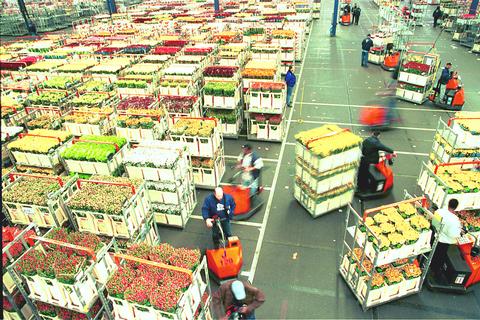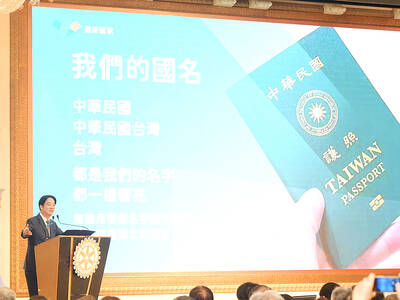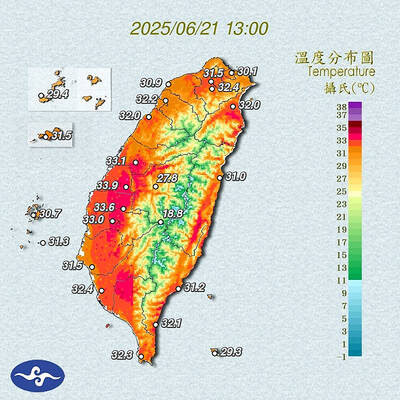Loek van Eeden stood amid hundreds of tulips in his walk-in refrigerator, stroking the whiskered petals of his Orange Rococo. The flower had fetched four times its normal price at the auction that morning and the Dutch farmer has buckets more to ship.
"When it opens, it's like a lion's mouth," he said, gazing inside the orange, yellow and green blossom. "The demand is so great for tulips now. The devotion is the same today as it was during tulipomania." Four centuries after "tulipomania," the bulb price inflation that swept through the Netherlands, tulips are still a powerful economic force. This week, growers prepare to harvest their fields in Zuid Holland, the province at the heart of tulip country.

PHOTO: BLOOMBERG
The flowers they pluck will soon find their way into markets around the world. Horticulture accounted for almost 40 percent of all Dutch agriculture in 1999 and 5.3 percent of exports. Cut tulip sales rose 21 percent to 390 million guilders (US$158 million) at major auctions last year, and they continue to expand even as the economy slows.

PHOTO: BLOOMBERG
Steady growth
"It is recession proof," says Dirk `t Hooft, chairman of the Aalsmeer Flower Auction, which had sales of 3.2 billion guilders last year and is the largest business of its kind in the world. "The good products just keep selling." Steady growth in the tulip and flower trade has steadied the Dutch agriculture as other sectors cycle through such disasters as the swine fever epidemic of 1997 and foot-and-mouth disease, which threatens to wipe close to one percent off gross domestic product this year.
The simple flower native to the mountains of Central Asia is the most widely grown blossom in the Netherlands and leads the country's flower industry, which added 9.5 billion guilders in sales to the economy in 1999. That's not counting the spillover effect to other industries, such as money flowing to hotels and restaurants each spring from the tourists who come to witness the sea of color.
The Netherlands now controls 80 percent of the world tulip market. The flower landed here in the 16th century, and became widely popular in the next, the "Golden Age," as it thrived on sandy soils and wet winters.
Betting on bulbs
Dutch merchants whetted the domestic appetite for the flower when they introduced the country to unprecedented wealth and goods from abroad. Traders bet all they had on tulip bulbs, hoping to resell them at double the profit, until the market collapsed in a single day in February 1637. At the market's peak, a single bulb could buy a canal-side mansion in Amsterdam.
Today, tulip prosperity also trickles down to other industries. While Royal Dutch KLM Airlines NV faced a 2 percent drop in passenger traffic in March, cargo rose by 5 percent, boosted in part by transport of tulips.
"Flower transportation is a growth market for KLM and becomes more important every day," said Bart Koster, a spokesman for Europe's No. 4 airline. Almost 2 million cut flowers from Aalsmeer are shipped every working day by air.
Horticulture contributed 38 percent to the Dutch trade surplus last year, more than any other industry. By doing so, it helped balance out the euro-zone's fifth-largest economy, where imports outpaced exports in three of last year's four quarters.
Aalsmeer's exports of cut flowers to the US rose 23 percent in the first-quarter, even as US consumer confidence slid to a 4.5-year low.
"When people have less money, they stay at home more and make their home cozier," said Adrienne Lansbergen, a spokeswoman for the Aalsmeer Flower Auction. "You may not be able to afford a new television but you can always buy flowers." Van Eeden, the tulip farmer from De Zilk, isn't worried about a global recession. He's preparing to send 110,000 yellow tulips to Mexico in a single week for Mother's Day. In a normal week, he ships 50,000 worldwide.
"The American interest in tulips is growing so much that even a slowing economy is good for us," said the farmer, who supplied white tulips for Princess Diana's funeral. One billion tulip bulbs, or a third of those produced in the Netherlands, are sent to the US every year, mostly for use in home gardens. The Dutch bulb business accounts for 93 percent of the world market, according to the horticulture commodity board.
Yet Ruth Haugen, one of those US home garden owners, is worried that her pink tulips won't bloom properly in Minnesota this year due to poor weather. So she hopped on a plane to the Netherlands to get a 24-hour dose of the flower.
"All those colors! What a doozy!" the 76-year old retired teacher said, after a tour of Keukenhof, a botanical garden in the heart of the bulb-growing region, and the Amsterdam market, where her daughter picked up some tulips for a friend. "I'll go back anytime to see those flowers." Haugen and others identify the Netherlands with the tulip for good reason. The 10,000 hectares of tulips account for 44 percent of all of the country's flower fields. And flower fields account for about 1 percent of Dutch land.
`Dutch auction'
The influence of the tulip stretches beyond the freshly mown fields each spring. The process through which they are traded, the "Dutch Auction," is not just a common expression, it is also the way US Treasury securities are traded.
Buyers who crowd Aalsmeer's auction rooms every morning at 7:30 bid backwards. That is, prices start at the highest point, usually a guilder per stem, and fall until a buyer finds an agreeable price. The system allows exporters to buy Dutch and imported flowers to be sold year-round and meet the moment's demand.
But there's an ugly side to the pretty flower, environmental groups say. The government does not restrict pesticide on tulip fields. In contrast, Dutch pig farmers have had to cut their herds by 10 percent and the government is tempting some to leave the business with a 1-billion guilder farm buy-back program in order to stem nitrate pollution.
"There's a tenfold profit for farmers on flowers from grains, so the culture is spreading, yet it's the most environmentally unfriendly crop we grow," said Joost Rutteman, a legal adviser to the South Holland Environmental Federation.
Pesticides used to treat the flowers also pollute ground water. To make the water drinkable, utility companies have to pay between 200 and 400 million guilders each year, a cost that is then passed on to the consumer, according to environmentalists.
The quality of water near a tulip farm is "so bad that nothing can grow or live near it; it's dead water," said Martijn Beekman of Greenpeace Netherlands.
The government is considering limiting pesticide use in the future, a spokesman said.
Still, consumers and growers love their flowers.
"The Netherlands is perfect for the tulip," Van Eeden said, bending over a white-tipped stem. "The tulip is like a Hollander, you can never push it down."

FREEDOM OF NAVIGATION: The UK would continue to reinforce ties with Taiwan ‘in a wide range of areas’ as a part of a ‘strong unofficial relationship,’ a paper said The UK plans to conduct more freedom of navigation operations in the Taiwan Strait and the South China Sea, British Secretary of State for Foreign, Commonwealth and Development Affairs David Lammy told the British House of Commons on Tuesday. British Member of Parliament Desmond Swayne said that the Royal Navy’s HMS Spey had passed through the Taiwan Strait “in pursuit of vital international freedom of navigation in the South China Sea.” Swayne asked Lammy whether he agreed that it was “proper and lawful” to do so, and if the UK would continue to carry out similar operations. Lammy replied “yes” to both questions. The

‘OF COURSE A COUNTRY’: The president outlined that Taiwan has all the necessary features of a nation, including citizens, land, government and sovereignty President William Lai (賴清德) discussed the meaning of “nation” during a speech in New Taipei City last night, emphasizing that Taiwan is a country as he condemned China’s misinterpretation of UN Resolution 2758. The speech was the first in a series of 10 that Lai is scheduled to give across Taiwan. It is the responsibility of Taiwanese citizens to stand united to defend their national sovereignty, democracy, liberty, way of life and the future of the next generation, Lai said. This is the most important legacy the people of this era could pass on to future generations, he said. Lai went on to discuss

AMENDMENT: Climate change is expected to increase the frequency of high-temperature days, affecting economic productivity and public health, experts said The Central Weather Administration (CWA) is considering amending the Meteorological Act (氣象法) to classify “high temperatures” as “hazardous weather,” providing a legal basis for work or school closures due to extreme heat. CWA Administrator Lu Kuo-chen (呂國臣) yesterday said the agency plans to submit the proposed amendments to the Executive Yuan for review in the fourth quarter this year. The CWA has been monitoring high-temperature trends for an extended period, and the agency contributes scientific data to the recently established High Temperature Response Alliance led by the Ministry of Environment, Lu said. The data include temperature, humidity, radiation intensity and ambient wind,

SECOND SPEECH: All political parties should work together to defend democracy, protect Taiwan and resist the CCP, despite their differences, the president said President William Lai (賴清德) yesterday discussed how pro-Taiwan and pro-Republic of China (ROC) groups can agree to maintain solidarity on the issue of protecting Taiwan and resisting the Chinese Communist Party (CCP). The talk, delivered last night at Taoyuan’s Hakka Youth Association, was the second in a series of 10 that Lai is scheduled to give across Taiwan. Citing Taiwanese democracy pioneer Chiang Wei-shui’s (蔣渭水) slogan that solidarity brings strength, Lai said it was a call for political parties to find consensus amid disagreements on behalf of bettering the nation. All political parties should work together to defend democracy, protect Taiwan and resist